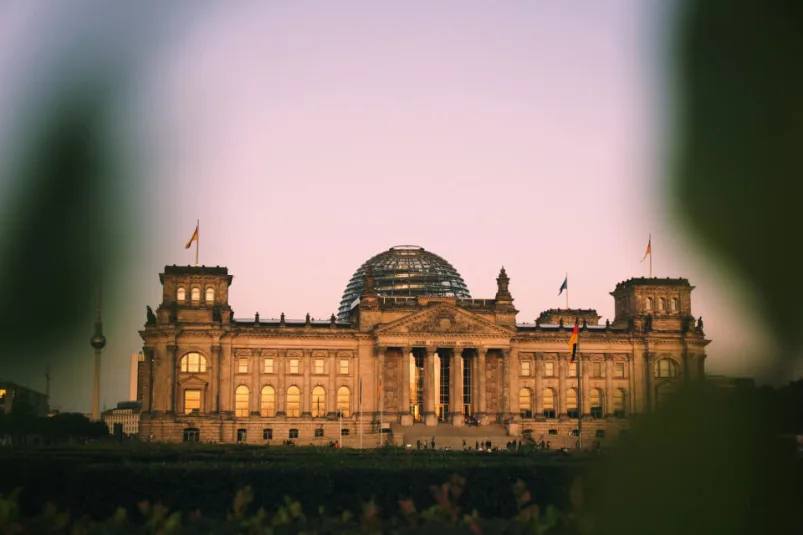Since When is Berlin the Capital of Germany?

Today, Berlin is undoubtedly considered to be the capital of Germany and one of Europe's major capitals. However, throughout history, its status has been subject to many upheavals. The city of Berlin was successively the capital of the Kingdom of Prussia, the Wilhelminian Empire, the Weimar Republic and then the National Socialist regime, before being divided in two by the infamous "Iron Curtain" for 40 years. It was only after the fall of the Berlin Wall and a very tense vote in the Bundestag that Berlin once again became the capital of Germany on 3 October 1990.
It is worth taking a brief trip back in time to the history of this city that has left its mark on Europe and to present the circumstances in which the city of Berlin first lost and then regained its title as the capital of Germany over the past 50 years.
1. Potsdam Agreement (1945)
In the aftermath of the Second World War, the winning states met in Potsdam to reorganize the maps of Europe, and in particular Germany. Under the Potsdam Agreement, the United States, the United Kingdom, France and the USSR each receive an area of German territory in which they exercise military and quasi-political control. Berlin is divided into four zones and is (literally) at the centre of the quarrels between the three Western powers and the USSR.
2. Growing tensions, Berlin blockade and the beginning of the Cold War (1945 - 1961)
In 1948, the Soviet powers, seeking to get their hands on the entire city, operated a blockade that paralyzed all road and waterways. This blockade forced the three Western powers to set up an air bridge to supply their garrison and the Berlin population. It was only a year later, in May 1949, that the Soviets, acknowledging their failure, lifted the blockade. As a result of this blockade, the Western powers established West Germany and the Soviet Union established East Germany.
East Germany or GDR (German Democratic Republic)
East Germany (GDR), under Soviet authoritarian rule, adopted the moral ideals embraced by the communist regime - such as the abolition of private property (in September 1945, large landowners were expropriated as a result of the "agrarian reform") and strict population surveillance measures (the Stasi, having deployed a large network of informants and agents, closely followed the opinions and activities of the inhabitants and excluded those who opposed the regime). The high point of these government activities was located in East Berlin, which had become the de facto capital of the GDR.
West Germany or FRG (Federal Republic of Germany)
West Germany (FRG) includes the areas occupied by the USA, France and the United Kingdom. Since 1949, these zones have constituted an independent state, officially imbued with more Western values, such as democracy and capitalism (but still under strong surveillance). The city of Bonn acts as the capital of the former Federal Republic as a "temporary solution".
Despite this separation, tensions intensified between East and West Germans and led to the construction of the Berlin Wall in 1961. On the night of 12-13 August 1961, the GDR erected a 44-km wall through the city of Berlin to stem the exodus of East Germans to West Germany. Alternately called the "Iron Curtain", the "Wall of Shame" or the "Anti-Fascist Protection Wall", the Berlin Wall is more than just a division of the city. It split Germany in two and became a symbol of the Cold War.
3. The fall of the Wall, Berlin becomes the capital again (1989-1990)
The fall of the Berlin Wall on 9 November 1989 already heralded the end of the communist bloc and paved the way for German reunification. In October 1990, the collapse of the communist bloc in Eastern Europe led to the disappearance of the GDR 41 years after its foundation. The GDR was finally absorbed by the Federal Republic on 3 October 1990, the date of German reunification.
With the reunification of Germany, the question of the future capital became crucial for German and foreign observers. By the Unification Treaty of 1990, and then by the vote of the members of the Bundestag on 20 June 1991, Berlin was chosen as the capital and seat of the unified German government. Why did Berlin become the capital? Assigning the status of capital to the city of Berlin is not only a logical choice because of its infrastructure and position, but it is also a symbolic choice since it crystallizes the destiny of Germany insofar as Berlin was the centre of the struggle for freedom during the division and reunification of Germany.
Berlin: a unique city
Berlin is a city that one might think was built on the adage "a civilization that forgets its past is condemned to relive it" (George Santayana, The Life of Reason). Indeed, it accurately mixes modern buildings that are open to the world with older ones, remnants of events that have marked the history of humanity. As such, the city of Berlin represents the symbol of a new reunited Germany. The architecture of its streets, monuments and buildings jealously preserves the testimonies of its history. The city becomes a showcase for the memory of the events that have had the greatest impact on Europe in recent centuries.

Raphaëlle Radermecker
Author
With a curious personality and a passion for well-chosen words, writing and discovery are my two passions. Berlin intrigues and fascinates me, with its cultural and artistic richness, its modernity and its ability to constantly renew itself.